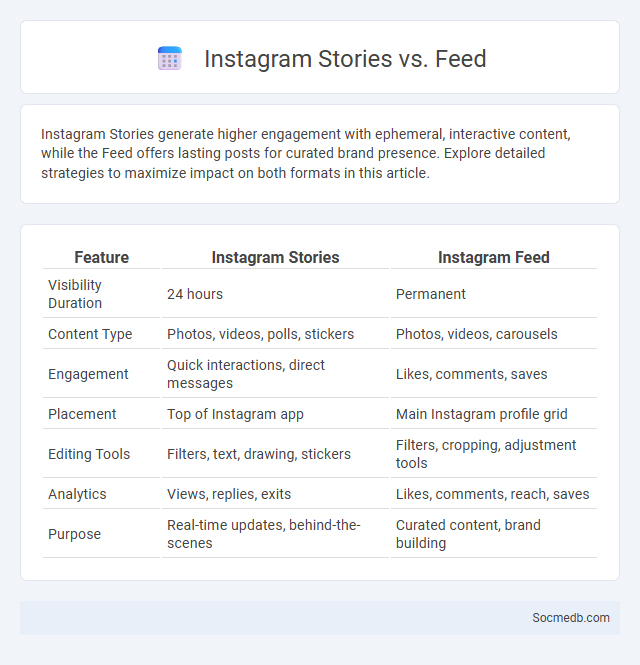
Photo illustration: Instagram Stories vs Feed
Instagram Stories generate higher engagement with ephemeral, interactive content, while the Feed offers lasting posts for curated brand presence. Explore detailed strategies to maximize impact on both formats in this article.
Table of Comparison
| Feature | Instagram Stories | Instagram Feed |
|---|---|---|
| Visibility Duration | 24 hours | Permanent |
| Content Type | Photos, videos, polls, stickers | Photos, videos, carousels |
| Engagement | Quick interactions, direct messages | Likes, comments, saves |
| Placement | Top of Instagram app | Main Instagram profile grid |
| Editing Tools | Filters, text, drawing, stickers | Filters, cropping, adjustment tools |
| Analytics | Views, replies, exits | Likes, comments, reach, saves |
| Purpose | Real-time updates, behind-the-scenes | Curated content, brand building |
Introduction to Instagram Stories and Feed
Instagram Stories offer a dynamic way to share moments with Your audience through photos and videos that disappear in 24 hours, encouraging real-time engagement and authentic interaction. The Instagram Feed showcases curated posts that remain on Your profile, allowing a more permanent display of content and brand identity. Combining Stories and Feed strategically enhances Your social media presence by balancing immediacy with lasting impact.
Key Differences Between Stories and Feed
Social media Stories are temporary, disappearing after 24 hours, and designed for real-time, behind-the-scenes content that encourages immediate engagement. Your feed consists of permanent posts that showcase curated, polished content intended for long-term visibility and interaction. Stories often feature interactive elements like polls and stickers, while feeds rely on captions and comments to foster deeper conversations.
Audience Engagement: Stories vs Feed
Audience engagement on social media varies between Stories and Feed content, with Stories generating higher interaction rates due to their ephemeral nature and interactive features like polls and stickers. Feed posts allow for more detailed content and permanent visibility, fostering sustained engagement through comments and shares. Brands often leverage Stories for real-time, authentic connections, while Feeds are optimized for building long-term community presence and searchable content.
Content Longevity: Ephemeral vs Permanent
Content longevity on social media varies significantly between ephemeral formats, such as Instagram Stories and Snapchat, which disappear after 24 hours, and permanent posts found on platforms like Facebook and LinkedIn that remain accessible indefinitely. Ephemeral content drives immediate engagement and creates a sense of urgency, while permanent content contributes to long-term brand presence and sustained audience reach. Balancing both types enhances overall social media strategy by combining timely interaction with enduring visibility.
Creative Tools and Features Comparison
Creative tools on social media platforms vary significantly, with Instagram offering robust photo editing, filters, and Reels for short video content, while TikTok excels in AI-driven effects and an extensive sound library tailored for viral challenges. Facebook provides comprehensive live streaming options and collaborative story creation, whereas Snapchat stands out with augmented reality (AR) lenses and instant sharing features. Comparing these, creators benefit from platform-specific features that enhance engagement and content originality, making the choice dependent on desired creative output and target audience.
Measurement & Analytics: Stories vs Feed
Social media measurement and analytics reveal distinct engagement patterns between Stories and Feed content, with Stories often generating higher real-time interaction through metrics like swipe-ups and reply rates. Feed posts tend to accumulate more sustained engagement measured by likes, comments, and shares over longer periods. Analyzing platform-specific analytics, such as Instagram Insights or Facebook Analytics, enables marketers to optimize content strategies by balancing the immediacy of Stories with the enduring visibility of Feed posts.
Best Uses for Instagram Stories
Instagram Stories excel in boosting real-time engagement by allowing brands to share behind-the-scenes content and limited-time offers. Utilizing interactive features such as polls, quizzes, and question stickers increases audience participation and collects valuable feedback. Consistent use of Instagram Stories drives brand visibility and fosters stronger community connections through authentic, ephemeral content.
Best Uses for Instagram Feed
Instagram Feed excels at showcasing high-quality, visually appealing images and videos that reflect your brand identity and engage your target audience effectively. You can leverage Instagram's algorithm by consistently posting authentic content, using relevant hashtags, and encouraging interaction through captions and stories. Optimizing your feed with strategic content planning helps increase visibility, foster community engagement, and drive traffic to your website or online store.
Brand Strategy: Choosing Stories or Feed
Selecting the right narrative for Your social media brand strategy directly impacts audience engagement and loyalty. Emphasizing Stories allows for real-time interaction and ephemeral content that fosters urgency and exclusivity, while a curated Feed builds a consistent, visually appealing brand identity over time. Balancing these platforms based on target demographics and campaign goals maximizes reach and reinforces brand messaging effectively.
Conclusion: Which Format Wins?
Video content consistently outperforms other social media formats in engagement rates and shareability, making it the most effective choice for brands and creators aiming to boost visibility and interaction. Your audience is more likely to connect with dynamic, visually rich posts that convey messages quickly and memorably across platforms like Instagram, TikTok, and Facebook. Prioritizing video ensures you maximize reach and impact in today's competitive social media landscape.
 socmedb.com
socmedb.com